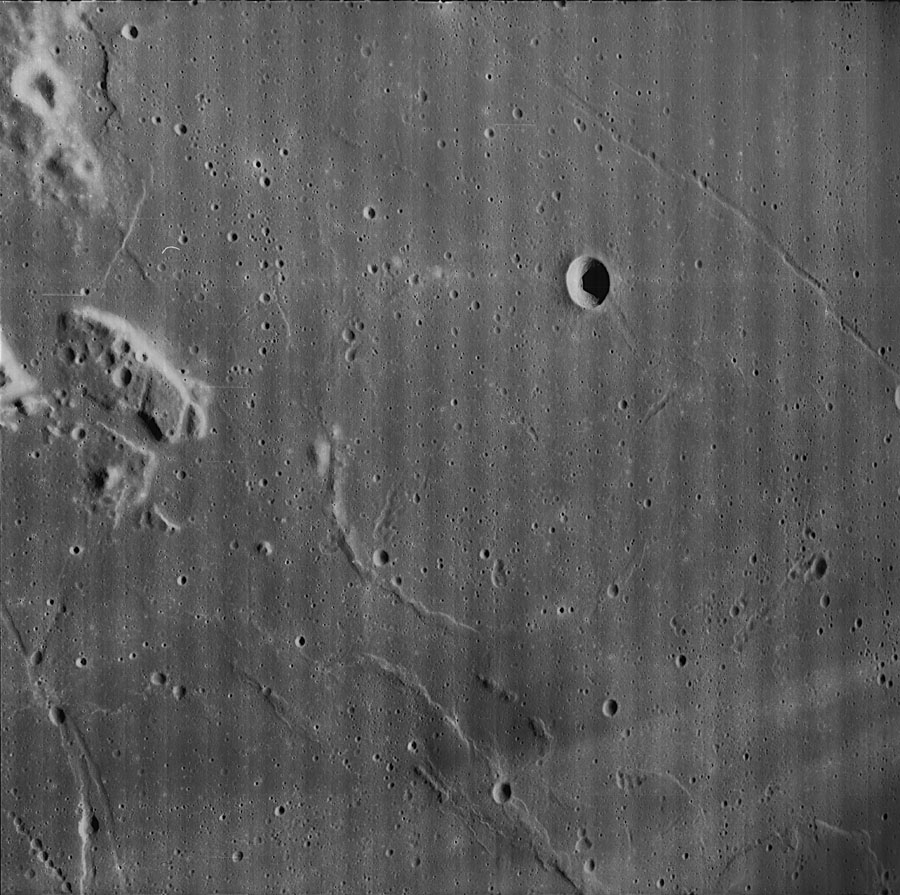Difference between revisions of "September 20, 2009"
| (2 intermediate revisions by the same user not shown) | |||
| Line 6: | Line 6: | ||
<em>Lunar Orbiter V-042 image from [http://www.lpi.usra.edu/resources/lunarorbiter/frame/?5048 LPI Lunar Orbiter Photo Gallery]</em><br /> | <em>Lunar Orbiter V-042 image from [http://www.lpi.usra.edu/resources/lunarorbiter/frame/?5048 LPI Lunar Orbiter Photo Gallery]</em><br /> | ||
<br /> | <br /> | ||
| − | I wonder if anyone other than Danny Caes recognizes this area? Danny recently pointed out some Lunar Orbiter V images of the Secchi Rille, and in looking at them I came across this other LO-V view that illustrates a lot of small scale lunar landforms. For geologic context see Paolo Lazzarotti's great telescopic [ | + | I wonder if anyone other than Danny Caes recognizes this area? Danny recently pointed out some Lunar Orbiter V images of the Secchi Rille, and in looking at them I came across this other LO-V view that illustrates a lot of small scale lunar landforms. For geologic context see Paolo Lazzarotti's great telescopic [[June_5,_2007|available]] at much higher resolution which shows that unlike the Hyginus Rille crater chain, these pits do not occur within a rille-like channel. Here the pits are the rille. These could be collapses into a lava tube, or perhaps blowholes above a tube. Looking diametrically across the image is the Messier Rille which has hints of within-rille pits but they could be a few random impacts. Also notice that the rille is not continuous - its middle section is offset about a rille width from the ends. When a linear geologic feature has such offsets it is said to have <em>en echelon</em> components. On Earth, faults at right angles to the linear feature cause the offset, but I am not sure here. In the middle of the image is less than half of a semi-circular mare ridge which looks to be an almost completely gone ghost crater. Below the ghost rim is a circular dark area with three elongated hills. These hills probably were the volcanic vents for pyroclastic eruptions that deposited the halo. A similar chain of vents with a more muted ash deposit is near the top center of the image. Finally, two more features to notice - the almost parallel bright streaks are the famous rays from Messier - see Paolo's image. There are a few other intriguing small features that I'll leave you to find.<br /> |
<br /> | <br /> | ||
<em>[mailto:tychocrater@yahoo.com Chuck Wood]</em><br /> | <em>[mailto:tychocrater@yahoo.com Chuck Wood]</em><br /> | ||
<br /> | <br /> | ||
<strong>Related Links</strong><br /> | <strong>Related Links</strong><br /> | ||
| − | Rükl plate [ | + | Rükl plate [https://the-moon.us/wiki/R%C3%BCkl_48 48]<br /> |
<br /> | <br /> | ||
<p><b>Yesterday's LPOD:</b> [[September 19, 2009|LPOD News]] </p> | <p><b>Yesterday's LPOD:</b> [[September 19, 2009|LPOD News]] </p> | ||
Latest revision as of 17:57, 13 October 2018
Little Treats

Lunar Orbiter V-042 image from LPI Lunar Orbiter Photo Gallery
I wonder if anyone other than Danny Caes recognizes this area? Danny recently pointed out some Lunar Orbiter V images of the Secchi Rille, and in looking at them I came across this other LO-V view that illustrates a lot of small scale lunar landforms. For geologic context see Paolo Lazzarotti's great telescopic available at much higher resolution which shows that unlike the Hyginus Rille crater chain, these pits do not occur within a rille-like channel. Here the pits are the rille. These could be collapses into a lava tube, or perhaps blowholes above a tube. Looking diametrically across the image is the Messier Rille which has hints of within-rille pits but they could be a few random impacts. Also notice that the rille is not continuous - its middle section is offset about a rille width from the ends. When a linear geologic feature has such offsets it is said to have en echelon components. On Earth, faults at right angles to the linear feature cause the offset, but I am not sure here. In the middle of the image is less than half of a semi-circular mare ridge which looks to be an almost completely gone ghost crater. Below the ghost rim is a circular dark area with three elongated hills. These hills probably were the volcanic vents for pyroclastic eruptions that deposited the halo. A similar chain of vents with a more muted ash deposit is near the top center of the image. Finally, two more features to notice - the almost parallel bright streaks are the famous rays from Messier - see Paolo's image. There are a few other intriguing small features that I'll leave you to find.
Chuck Wood
Related Links
Rükl plate 48
Yesterday's LPOD: LPOD News
Tomorrow's LPOD: Peas in a Pod
COMMENTS?
Register, Log in, and join in the comments.



